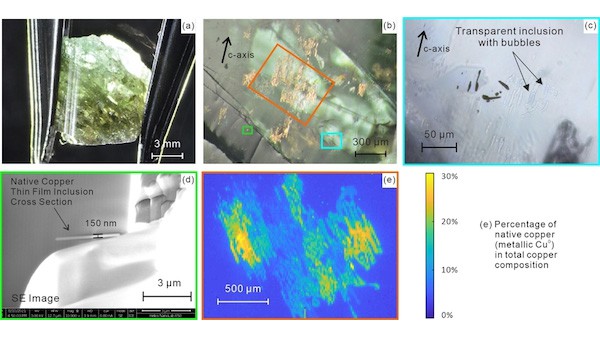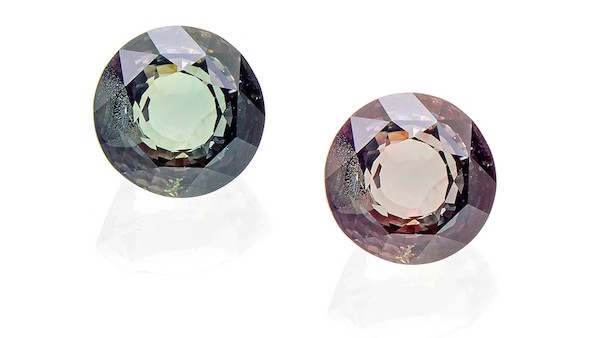
Native copper inclusions in copper-bearing tourmaline: a new formation scenario?
by Dr. H.A.O Wang, first published in Facette 28 (May 2023)
Gold-coloured platelet inclusions have been reported in copper- bearing tourmaline from Paraíba State in Brazil since the discovery of this highly sought-after gemstone (Fritsch et al., 1990) in the late 1980s. Until now, this extraordinary type of inclusion in tourmaline was mentioned in the literature only occasionally, probably due to its rather rare appearance (Fritsch et al., 1990; Koivula et al., 1992; Brandstätter and Niedermayr, 1994; Hartley, 2018).
A previous study by Koivula et al. (1992) pointed out a possible growth scenario for this type of inclusion as an epigenetic exsolution from the host copper-bearing tourmaline. Epigenetic exsolution means that the inclusion formed after the crystallization of the tourmaline and copper was extruded from the tourmaline into host mineral fractures, instead of being added from external sources. Brandstätter and Niedermayr (1994) also proposed an epigenetic exsolution formation scenario of copper, which seemed for them more plausible than the syngenetic precipitation scenario of native copper on the surface of tourmaline during growth.

In a recent joint research project by SSEF, the microXAS beamline at the Swiss Light Source, the Paul Scherrer Institute, the University of Basel and the University of São Paulo, we investigated a rough copper- bearing tourmaline (elbaite) from Paraíba state in Brazil (Figure 1a). This yellowish-green tourmaline contained plenty of native copper inclusions showing an orangey yellow colour under a reflected light microscope (Figure 1b). The inclusions show a preferred orientation along the c-axis of the host tourmaline and cluster in rather large planar surfaces, which are mostly parallel to each other. Additionally, abundant transparent inclusions showing a similar morphology and orientation as the native copper inclusion were observed in the sample (Figure 1c). As far as we know, this type of transparent inclusion has not been reported previously in copper-bearing tourmaline and we interpreted them as being fluid inclusions because occasionally round (gas) bubbles were found inside these inclusions. To further characterise the native copper inclusions, we used a focused ion beam scanning electron microscope (FIB-SEM) to cut into the tourmaline and expose the cross-section of such a typical native copper inclusion (Figure 1d). The thickness of the native copper (thin lm) inclusion is about 150 nm across the entire width of about 3-4 μm.
To the best of our knowledge, such gold-coloured platelet inclusions were so far assumed to be native copper, however without direct experimental evidence so far. In our latest experiment, the characteristic local copper oxidation state of a typical inclusion and the host tourmaline were revealed by using spatially resolved synchrotron radiation x-ray absorption spectroscopy (SR-micro-XANES). The absorption spectrum at the copper K-edge is very sensitive to different redox (and coordination) states of copper. The observed chemical and electronic contrast can be used to construct chemical images depicting the electronic state of Cu (copper “redox-maps”) in Fig. 1e of metallic copper (Cu0) distributions on a typical inclusion, which is approximately 5 μm beneath the tourmaline surface. The highest Cu0 composition goes up to only about 30% because it is thin and embedded under the tourmaline surface. The rest of the Cu composition is contributed from oxidised Cu (Cu2+) most probably located in the tourmaline crystal structure. These results are the first and direct proof that the gold-coloured platelet inclusions in copper-bearing tourmaline from Paraíba are indeed native copper in their metallic state.
In combination with additional observations, especially the presence of fluid inclusions of similar morphology as the native copper inclusions, epigenetic exsolution may not easily explain the formation of this type of native copper inclusions. Instead, a syngenetic (epitaxial) growth of native copper during the formation of the host tourmaline is considered a more likely scenario in our opinion. Nevertheless, we cannot fully exclude the formation of such a native copper (thin lm) inclusion by fracture filling with fluid after the formation of the tourmaline with the native copper being precipitated from the fluid inclusion. Further detailed research is ongoing, to better understand these fascinating native copper inclusions in tourmaline in the context of the formation of attractive copper-bearing tourmalines from Brazil. This study also revealed that cutting-edge (micro-) analytical methods new to gemmology have a high potential to provide new insights to characterise gemstones and their formation.
References
Brandstätter, F. & Niedermayr, G. 1994. Copper and tenorite inclusions in cuprian-elbaite tourmaline from Paraíba, Brazil. Gems & Gemology, 30(3), 178–183, https://doi.org/10.5741/gems.30.3.178.
Fritsch, E., Shigley, J.E., Rossman, G.R., Mercer, M.E., Muhlmeister, S.M. & Moon, M. 1990. Gem-quality cuprian-elbaite tourmalines from São José da Batalha, Paraíba, Brazil. Gems & Gemology, 26(3), 189–205, https://doi.org/10.5741/gems.26.3.189.
Hartley, A. 2018. Gem Notes: Native copper inclusions in a Cu-bearing tourmaline. Journal of Gemmology, 36(3), 203.
Koivula, J.I., Kammerling, R.C. & Fritsch, E. 1992. Gem News: Tourmaline with distinctive inclusions. Gems & Gemology, 28(3), 204.
Want to learn more about tourmalines?
Start your journey to becoming a tourmaline expert with our free online course “Introduction to tourmalines”. Learn all about tourmalines. Their fascinating history, how they form, where they come from. Learn about all the different origins of tourmalines and their treatments. Take this course as an introduction to the wonderful world of tourmalines.


